The 1958-1961 Great Leap Forward, when millions starved to death in late chairman Mao Zedong`s botched industrialization campaign, and the Cultural Revolution are two of modern China`s most sensitive historical events.
Fan Jianchuan, who opened his Jianchuan Museum Cluster to the public in 2005, said his relics, which refer discreetly to a "Red era", were beneficial to the nation.
"I have a saying: We don`t speak. Let the cultural relics talk," Fan told Reuters TV.
"Our nation`s cultural treasures need to be inherited ... but it is more important to pass on the nation`s experience and some lessons. That`s why I have stayed with this cause for decades."
During the Cultural Revolution, children turned on parents and students on teachers after Mao declared class war, convulsing the country in chaos and violence. The upheaval affected industry as well, including the critical steel sector.
From 1967 to the end of 1968, thousands of steel mills were occupied and closed down, slashing steel output. China`s cabinet, or the State Council, was forced to step in, ordering steel enterprises to cease the "struggle" and restore output.
While recent years have seen increased public discussion of both events, certain topics remain almost completely off limits, including the death of Lin Biao, once handpicked to succeed Mao but killed in a mysterious plane crash in 1971 while fleeing China having been accused of plotting a coup.
Students who toured the museum in a suburb of the provincial capital Chengdu, listened carefully as their guide explained a period in China`s history that is largely missing in their textbooks.
Luo Qingsong, one of the students from Sichuan Management Professional Institute, said the Cultural Revolution could not happen again in China today.
"I think modern China is an open country and integrated into the world. I believe our party, the country and our leadership would not adopt such policies again," Luo said.
More about:















































